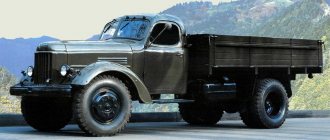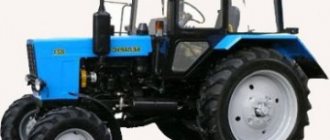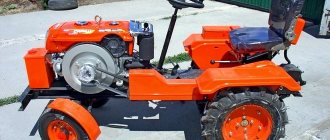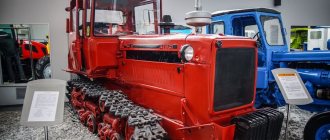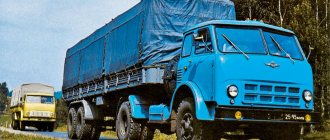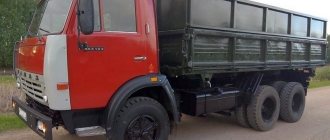There are vehicles that can be described as successful and unique in their qualities and basic technical characteristics. In the history of the country, there are many different examples of high-quality and functional trucks. Among them, 51 GAZ deserves special attention. This is a real example of how the basic technical characteristics of the car were used as sensibly as possible, which became the real key to the ever-increasing versatility and functionality of the truck. The main model was produced for 29 years, more than 3.5 units of the 51st GAZ were assembled and sold.
History of GAZ 51
In the first decade of operation of the famous Gorky plant, the concern followed the instructions and basic concepts of the world-famous Ford company. Previously, it was a car with a body and or cab from a given manufacturer. The main history of creation begins around 1937. During the production process, it was decided to use exclusively the most proven, popular units in the West. Based on them, it was necessary to assemble reliable and simple working cars.
During the sales process, the car constantly underwent road tests, and from time to time the manufacturer sent the car to agricultural exhibitions. During the war, a car was produced based on units of this particular brand of truck, and all available reserves were used. On this basis, the truck turned out to be truly unique.
The utility dump truck began to be produced again in 1945. After a year of testing and development, not only trucks, but also buses began to arrive on the assembly line. Each model underwent a test drive before being sold, which is why the bus and truck were constantly improved. The manufacturer began to produce 3,100 fully finished cars per year, including a bus. The models were of such high quality that many characterized them as ultra-reliable, maintainable and simple in design. Also at the height are the numerous technical characteristics that each bus and truck is equipped with, as well as the built-in GAZ brand 51 gearbox.
History of the machine
The need to create a new truck with a carrying capacity of 2.5 tons arose in the Soviet Union back in the mid-30s. The machine had to meet the following requirements:
- The car must serve both in the army and in all sectors of the national economy;
- It was planned to create a universal chassis on which various equipment could be installed. Priority was given to flatbed modifications, dump trucks and buses for transporting people;
- The carrying capacity of the new machine had to be at least 2.5 tons;
- The motor must provide good speed characteristics and traction;
- The truck had to be structurally simple, and its repairs had to be carried out independently without any problems.
In the summer of 1938, the designers developed and launched production of the components necessary to assemble the car, and in 1939 the first prototypes were already assembled.
The power and load-carrying capacity of the new car so impressed the commission during testing that after 18 months the new car was recommended for launch into mass production. In 1940, the new truck was presented at the VDNH exhibition in Moscow, after which all documentation for it was transferred to the plant for serial production.
The outbreak of the Great Patriotic War crossed out all the plans of Soviet designers, forcing them to completely switch to the production of tanks and military wheeled vehicles. It was decided to use the already completed developments in the production of military equipment for the front. The following components were taken from the GAZ-51:
- Engine and gearbox;
- A new design of cardan, which used crosspieces on needle bearings;
- New clutch with release bearing and other components.
During the war, all these units showed their best side.
When it became clear that victory in the Great Patriotic War was just around the corner, the plant again began work on preparing the GAZ-51 for mass production. Already at the end of 1945, the Gorky Automobile Plant was able to produce the first batch of 20 trucks. The gearbox was slightly modified, the steel frame was strengthened, and in 1946 the plant was able to produce 3,136 units of GAZ-51 trucks.
Specifications
The manufacturer installs the highest quality and most reliable engines on trucks and buses. Previously, the plant had a special license to produce and install a special Dodge lower-valve engine in cars. As production capabilities developed, engines were constantly improved and modernized. The engine is covered with chrome, which is present on the piston rings. There is also home-made wear-resistant cast iron. It is also used as a material for cylinder liners. The machine is equipped with an engine that is equipped with a high-quality oil cooler and preheating.
Engine GAZ 51
The crankshaft included in the most reliable engine is equipped with special steel liners. All this ensures durability of the motor and the entire machine in a wide variety of operating conditions. In addition to the unique quality engine, the machine is characterized by the following technical characteristics:
| Length | 5500 mm |
| Width | 2200 mm |
| Height | 2120 mm |
| Wheelbase | 3300 mm |
| Curb weight | 2750 kg |
| Fuel tank volume | 3484 cm cube |
| Engine power | 2800 rpm |
| Transmission | Manual transmission 4 |
| Maximum speed | 80 km per hour |
| Fuel consumption | 20 l per 100 km |
| Load capacity | 2500 kg |
Based on these indicators, we can conclude that all cars based on GAZ have unique traction. The car has a standard gearbox. Repair of the GAZ model 51 truck could be carried out without any problems, since there were no difficulties in purchasing spare parts throughout the entire life of the models.
Cabin structure
The truck's cabin was initially modest. It was a wooden structure with metal parts and a canvas roof. This was due to a shortage of thin rolled steel. Over time, the cabin acquired a rounded shape, and corrugated metal steps appeared on it.
GAZ-51 truck interior
Manufacturers have tried to provide the driver with comfortable driving conditions. The two-seater truck was equipped with many devices that did not yet exist in a lorry. Among them:
- a full set of instruments on the control panel;
- watch;
- windshield that slides forward and upward;
- manual drive of windshield wipers;
- heating system.
Video on the topic: Test drive GAZ-51
Publications on the topic
Technical parameters of the GAZ-4301 truck
Technical characteristics and general description of the GAZ-33104 Valdai truck
Technical parameters and modifications of the KamAZ-43114 flatbed truck
Structural advantages of the car
Vehicles are able to withstand quite severe operating conditions, since the vehicle is equipped with the highest quality frame. The car was characterized as the most reliable. The driver could start the car even with a faulty starter, as well as with a completely broken battery. This could be done using a special starting handle. The wheelbase of the car deserves special attention. Its size is only 3.3 meters, but the slightly shifted forward cabin of the GAZ line 51, as well as the most thoughtful engine location, made it possible to obtain a large amount of free space. It is there that the GAZ mark 51 gearbox is located.
Frame GAZ 51
The general design of the 51st GAZ is advantageous. Each car block contains one or two parts that are designed to take on a serious load. These include an easily removable drum built into the brake mechanism, a separate compartment for the oil pump, as well as plug-in valves. Replacing such parts was not difficult, therefore, with proper operation, the GAZ 51 and its technical characteristics do not change over time, and the total service life of the engine, GAZ 51 gearbox and the car itself can reach 50 years.
Models of the 51st GAZ are still in use today. The cars undergo special improvements, undergo tuning and look very rare. Many people install serious decorative body kits on their cars, sometimes completely remodeling the car.
The advantage is not only the engine of the GAZ 51 car, but also its frame, which is additionally reinforced with a special cross-shaped cross member. The design features of this element are able to provide an ideal connection between numerous spars. At the same time, special towing hooks are attached to the frame. They are under the wings.
Engines of GAZ-51A, GAZ-63 and GAZ-12 cars
The GAZ-51A has a carburetor, four-stroke, in-line, six-cylinder engine.
All cylinders are cast from cast iron in one block along with the crankcase. Thin short liners made of special cast iron are pressed into the upper part of the cylinders.
The cylinder head, made of aluminum alloy, is mounted on a steel-asbestos gasket and attached to the block with studs. Steel washers are placed under the stud nuts.
Aluminum alloy pistons have an elliptical profile skirt and a side non-through U-shaped cut. The surface of the skirt is tinned. The normal clearance between the piston and cylinder is 0.024-0.036 mm. There is an arrow stamped on the bottom of the piston for correct installation. There is a heat-insulating groove at the top of the piston.
The piston is equipped with two compression rings and two oil scraper rings. Both compression rings have a chamfer on the inside with which they are installed upward. The chamfer ensures some taper of the rings when they are installed in the cylinder. The top ring is chrome plated, all other rings are tin plated. There is a groove with through slots around the circumference of each oil scraper ring. The gap at the junction of the rings is 0.2-0.4 mm. The height gap is 0.05–0.08 mm for the top ring and 0.035–0.07 mm for the remaining rings.
The piston pin is floating, made of carbon steel and subjected to surface hardening. h.; it is secured in the piston bosses with two retaining rings.
The connecting rods with an asymmetrical lower head are made of manganese steel. A bushing made of sheet bronze is pressed into the upper head of the connecting rod; There is a cut in the upper part of the connecting rod head for the passage of lubricant. The lower head of the connecting rod is detachable; it is equipped with thin-walled interchangeable steel liners with Babbitt filling. There is a hole in the top of the head for spraying oil. The cover is attached to the connecting rod with two bolts. Serial numbers are stamped on the lower heads and covers. The connecting rods are placed so that the lubrication hole and the stamped number are located towards the camshaft.
The crankshaft is made of carbon steel, four-bearing, with counterweights. The shaft journals are surface hardened. h. The bearings have steel interchangeable liners with Babbitt filling. The upper liners differ from the lower ones in the presence of a hole for the supply of lubricant and the shape of the oil groove. Each bearing cap is secured with two bolts. Lubrication channels are made in the shaft journals.
The crankpins of the shaft are equipped with dirt-collecting chambers, which are drilled into the crankpins and are closed from the outside with threaded plugs.
The rear main bearing is wider than the others. The rear bearing shell has an additional annular groove that prevents oil from escaping from the rear end of the bearing. Oil from the groove is discharged into the crankcase through a hole in the lower liner and in the cover.
Suspension and transmission
The suspension in this car is dependent and at the same time quite modern. It contains built-in four longitudinal springs, which have a semi-elliptical shape. A fairly far-sighted solution is to use special hydraulic and lever shock absorbers with special double-sided action on the front suspension of the car. Ideal stability is ensured by a heavy kingpin, a rigid front axle, and a steering knuckle.
Springs GAZ 51
Modifications of the model range
According to documents and official data, the car was assembled not only in Russia, but also in other countries. After the main model was completely discontinued, its popular successors were produced for about 11 years. Here are some of the most popular and functional quality GAZ car models:
- GAZ-51U is the very first modification, which was intended for export to various tropical countries;
- GAZ-93 is a dump truck with a shortened chassis;
- GAZ-51N is a popular military version in wartime;
- GAZ-51R, as well as GAZ-51T - a more comfortable cargo-passenger and cargo taxi;
- GAZ-63 – SUV;
- GAZ-51V - a model with an increased payload capacity of up to 3.5 tons;
- KAvZ-651, GZA-651 and 651A are buses of a special bonnet category.
Various variations of GAZ 51
Over the entire production period, the car has had three different generations of cabins. Originally a metal cabin with two wooden doors, it was designed to replace the less durable wooden structure. Recently, the car was produced with a solid metal cabin and rigid welded mudguards.
A decent amount of various protective and high-quality waterproofing parts are installed in the car cabin. As for the color scheme, the cabins were made in green, gray, and beige shades. For special models, a bright orange warning color was used.
Cabin GAZ 51
